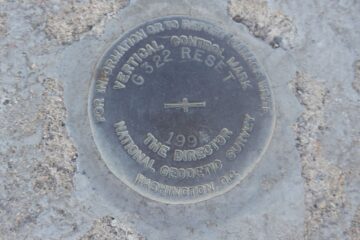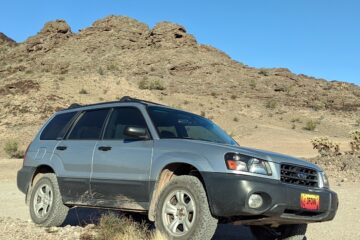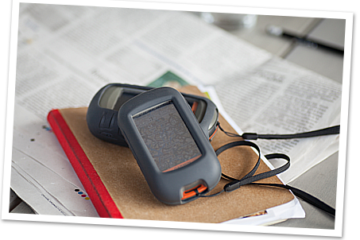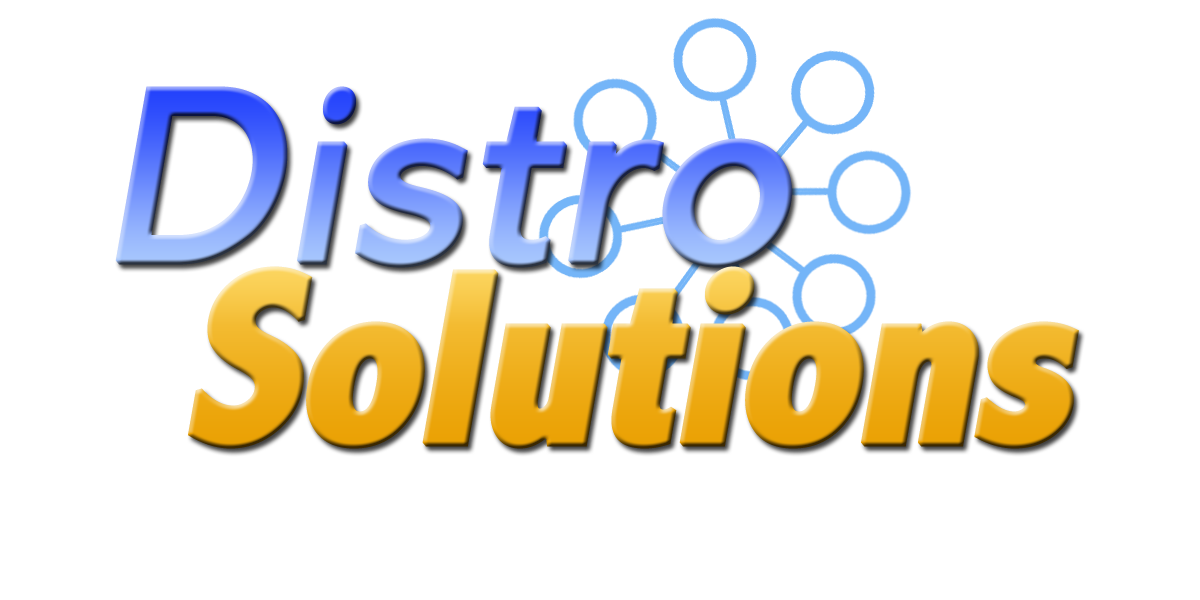Hi, my name is GeoElmo6000 and I am a geocacher from New Jersey. Geocaching started me on a new hobby: filmmaking! I’d like to share my story, hoping it inspires you to give video creation a try, and I’d also like to share some filmmaking tips for beginners.
In 2013, I had the privilege of attending the Geocaching Block Party (GC3X684) in Seattle. On the day of the event, I flew six hours across the country, rented a car, and drove to Geocaching HQ. I spent the day meeting geocachers and finding all the HQ GeoTour caches, even winning a geocoin for completing the tour. It was a great but very long day!

Winning a geocoin at the 2013 Block Party from Geocaching HQ’s MissJenn
That night I attended the inaugural Geocaching International Film Festival (GIFF) (GC4C466), which was held outdoors on a large screen under the nearby Aurora Bridge. The event started around 9pm, which was midnight for my body. Though I was exhausted, I was captivated as I watched sixteen short films about geocaching playing for the crowd! I admired the geocachers who could create short films, but with no video creation experience, believed filmmaking was something I would never be able to do.
In 2016, GIFF events had been decentralized, and I hosted a GIFF event (GC6V5Z3) at a local movie theater. Among the attendees were finalist film creators LinedUpLikeLemmings and ace48, who had entered the short film “NYC Caching: Muggle Madness!”. The event was a success, with the attendees having a great time enjoying all of the short films.
After the event, I spoke with the two film creators and asked about the making of their short film. What did they use for a camera? How did they edit? What was the GIFF submission process like? It was in that conversation that I realized that creating a short film wasn’t impossible like I had thought it was. They gave me some great tips from their filmmaking experience, and I decided that day that I would enter a short film for the next GIFF event.
Over the next year, I spent time learning filmmaking by reading lots of articles and watching lots of YouTube videos. I wrote up a story idea, asked some geocaching friends to help, and was soon on my way to creating my first short film.
In 2017, a short time after submitting my GIFF entry “A Travel Bug’s Life”, I received the fantastic news that my film was a finalist! The film was seen at over 600 global GIFF events by over 15,000 geocachers. I created a YouTube channel to show my short film after GIFF was done, calling the channel Geo Elmo Geocaching. Since then I have created many other geocaching short films.

A scene from “A Travel Bug’s Life” filmed at the shore in Ocean Grove, NJ
The film I created for the 2018 GIFF, which I called “:-)”, was not selected as a GIFF finalist, but my 2019 entry “The Geocaching Express 6000 GPS Receiver” was selected for that year’s GIFF.
Now that I’ve shared my filmmaking success story, I wanted to pass along some tips to you on how to become a filmmaker. Don’t let this information overwhelm you; my first film was very basic, and I’ve been learning new techniques each time I create something.
First, what is filmmaking? Filmmaking is storytelling, done through video and audio. The first question I ask potential filmmakers is “What’s your story?”; it should be something that comes from you. Will you share something funny and relatable? Do you have an experience that is personal and inspiring? Will you take the audience along on a geocaching adventure?
Next, plan your story. I start with an outline of how my story will progress; oftentimes I find problems just writing the outline and I make many necessary adjustments. Afterward I fill in the details, breaking the story into a list of shots I want to film. Who will be in each shot? Where will I film each scene? What dialog will my actors say? Remember that films do not have to be shot in order.

Reviewing a list of scenes to be filmed; these may be shot in any order, and made sequential in the editing process
Below is an example from my 2019 GIFF entry, “The Geocaching Express 6000 GPS Receiver”
| Distance | Shot # | Description | Dialog | Location |
| Far | 1 | Geocacher signing a log, main character (MC) runs into shot | Announcer: Are you tired of narrowly missing being First to Find? | Cache #1 |
| Close-up | 2 | MC, looking at the camera, tired from the run | MC: I’m just never fast enough! | Cache #1 |
| Medium | 3 | MC looking through travel brochure (NYC?), reading through looking frustrated | Announcer: Are you unable to get to great faraway geocaching locations? | Open field |
| Close-up | 4 | MC, looking at the camera, frustrated | MC: Who can afford to travel these days? | Open field |
| Close-up | 5 | MC, looking interested – continuation from previous | Announcer: Well I have a solution for you! | Open field |
While cameras are important, you may notice that I haven’t mentioned them yet, because everything should be planned out first. Before you start filming, have some friends review your film script; they can provide important insight into whether your idea works well or whether it needs some changes.
Filming can be done on a camera as simple as a smartphone. I created my first GIFF finalist film using an iPhone 7, and it looked terrific when shown on a large indoor movie theater screen. Make sure to use full HD (1920×1080) in landscape mode at a minimum when filming for best results.
Different cameras have different strengths and weaknesses. While a smartphone’s picture quality is great, for most shots the phone won’t be close enough to an actor to pick up dialog very well. My first film had no dialog, so using a smartphone wasn’t an issue. My second film was shot using a Panasonic Lumix G7, a mirrorless camera that looks like a Digital SLR camera. While a smartphone is point and shoot, using the Lumix to the best ability requires the operator to understand more advanced camera techniques. With the Lumix I was able to connect a microphone directly to the camera for good audio quality to record the dialog.
When possible, using a tripod keeps the camera steady and makes the film look more professional.
Audio is important for films, if the film has dialog; many filmmakers argue that bad audio will more easily ruin a film than bad video. For my first finalist film, I had no dialog, so using my iPhone was sufficient. My second finalist film was heavy on dialog, so for good audio quality I used a Rode VideoMic Go shotgun microphone that was run by audio cable from a boom (an extendable and adjustable arm to which a microphone may be mounted) to my camera. I would start recording the video, then hold the microphone just outside the camera’s view to pick up any speech. Another option is a lavalier microphone, which clips to the actor’s shirt. I use this when recording documentary videos, as a microphone showing in this type of video is acceptable while in a short film it is not.

Panasonic Lumix G7 camera with Rode Videomic Go with windscreen;
Rode Smartlav+ lavalier microphone connected to iPhone with Rode Rec app
Wind may be a factor when recording audio, as it will overpower any other sounds being recorded. The best option is to record when there is little to no wind. However, on my lavalier and shotgun microphones, I use a windscreen to reduce wind noise.
Audio doesn’t need to be recorded directly into the camera; instead, I often use a smartphone or tablet to record my audio using a recording app. Since I use Rode brand microphones, I purchased the Rode recording app, which works very well. If the video and audio are recorded separately from each other, they can be merged together during editing. I use the old movie trick of clapping on camera to synchronize the video and audio; the spike in the noise level can be used in the video editor to synchronize the two tracks.
Background music is important in films; it sets the tone and feeling of the film. I’ve created several videos in which, without any background music, they are painfully boring to watch. Adding background music transformed them from dull videos into fun films. Free music is widely available online, though be aware that you should always check for the rules on using it. Some artists require attribution for their works, which will be stated wherever you find the music. For a trivia challenge video I created, I used “fun” music to set the tone of the film since the right and wrong answers were silly. For a recent documentary, I chose to not use any background music, as I felt it was interfering with the information I was trying to convey.
Lighting is important but can be difficult; it’s the aspect of filmmaking I’m working the hardest to master. Filming outdoors can lead to beautiful shots, but many factors need to be considered, such as shadows across the actors’ faces, actors needing to squint due to sun in their eyes, overexposing parts of the shot, and many other factors. Filming on a cloudy day takes away some of those variables, as the lighting is more even and there are less shadows. Some things I’m learning to use are neutral density (ND) filters, reflectors, and key and fill lights, but I’m not an expert enough to share how to use those yet.
To put the video, recorded audio, and music together, you will need editing software. I use iMovie on a Mac, because it’s free and works well for what the films I create. Editing software may be purchased and may contain more features than free software.
When editing your film, the biggest goal you should have is to make the film something that you would enjoy watching. Make sure:
• There isn’t unnecessary dead time
• The film tells your story succinctly
• Audio and music aren’t too loud or too soft
• You give credit to any actors and artists whose works you’ve used
• Don’t rush; oftentimes I’ll take a break from editing and return fresh later
Filmmaking is a very rewarding hobby. I hope my story helped to inspire you to try it yourself, and the technical information I shared allows you to get started easily. I learned most of what I know through Google searches, watching YouTube, and trial and error.
The biggest tip I can share is this: don’t be afraid to fail! Try it, and if you don’t like how something turned out, try it again. I’ve scrapped hours of work with actors because video quality wasn’t turning out well and was rewarded with a much better film because of it. My first film was accepted into the 2017 GIFF, and although the next year my entry wasn’t selected, the following year I tried again and was once again selected. Never let failure stop you from trying.
Best wishes with your filmmaking! I hope to see your works on the big screen or on YouTube someday!
Have you thought about (or currently do) make geocaching films of some sort? How do these tips help?
GeoElmo6000 has been geocaching for eight years, and has found the hobby to be a fit with his love for the outdoors and exploring. When not geocaching or creating short films, he may be found running, biking, swimming, or spending time with his family. Please join GeoElmo6000 on his YouTube channel (Geo Elmo Geocaching), Instagram (@geoelmogeocaching), Facebook (Geo Elmo Geocaching), and Twitter (@geoelmogc).
The Geocache Talk blog wants your geocaching-related stories, DIY tricks, and insights. Please contact me, Angie (aka @GeoJangie and blogger on www.GeocachingJangie.com), to write a guest blog post or if you have any recommendations for subjects or authors. I can be reached via my email: JangieGoWest@gmail.com or through Instagram, Twitter, or Facebook.
Enter your email address below to receive each new Geocache Talk blog post directly into your inbox!




